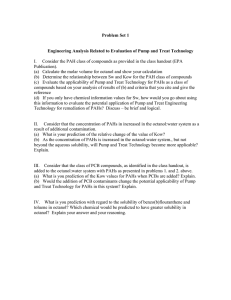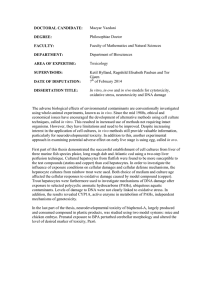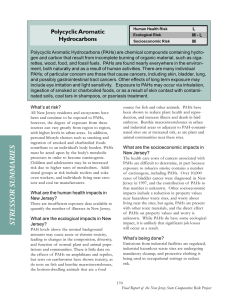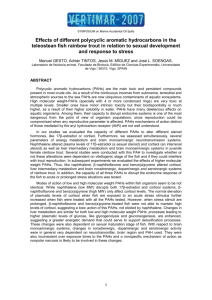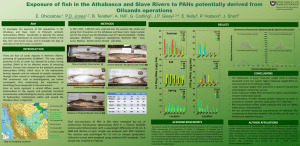Barata_Carlos_et_al.ppt
advertisement
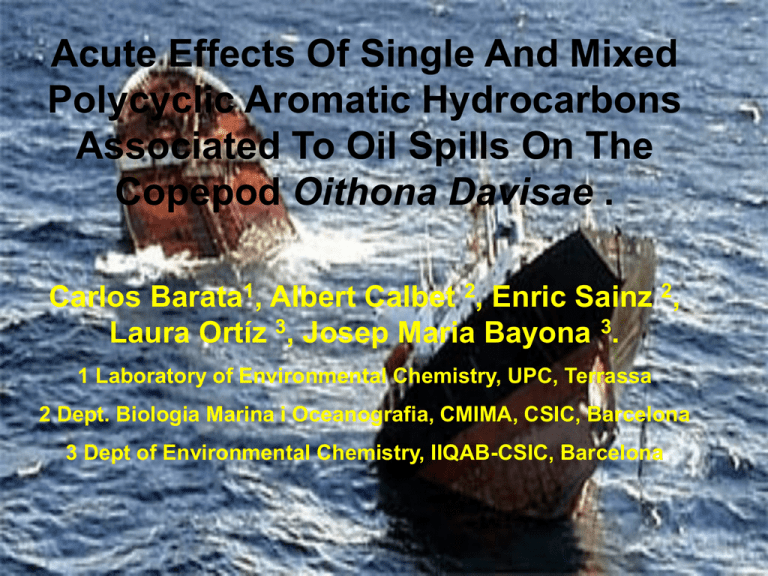
Acute Effects Of Single And Mixed Polycyclic Aromatic Hydrocarbons Associated To Oil Spills On The Copepod Oithona Davisae . Carlos Barata1, Albert Calbet 2, Enric Sainz 2, Laura Ortíz 3, Josep Maria Bayona 3. 1 Laboratory of Environmental Chemistry, UPC, Terrassa 2 Dept. Biologia Marina i Oceanografia, CMIMA, CSIC, Barcelona 3 Dept of Environmental Chemistry, IIQAB-CSIC, Barcelona Acknowledgements Financial Support: • MEC Spanish project PETROZOO (VEM200320037). •MEC R y C contract to Carlos Barata and Albert Calbet Objectives Develop a modelling framework to predict the toxicity of mixture combinations of petrogenic PAHs in copepod species Overview – in brief Effects of crude oil spills in marine planktonic food webs??? zooplankton species constitute the major food source for larval fish Overview – in brief Polycyclic aromatic hydrocarbons (PAHs) Environmental fate 1. Most toxic and persistent components of class 2 fuel oils (Prestige) Toxicity by non-polar narcosis 1.Toxicity = F (1/log Kow) Effect 2.Toxicity complex mixtures is additive Toxicity – EC50 2. Occur in complex mixtures Log Kow PAHs Methods Test Species: Oithona davisae Chemicals: Naphthalene, 1-methylnaphthalene, 1,2-Dimethylnaphthalene Phenanthrene,1-methylphenanthrene,3,6-dimethylphenanthrene Fluorene, Dibenzothiophene, Pyrene Analysis: SP -HPLC-UV Measured variables: Lethal , Narcosis– after 48 h (%) Experimental design Exposure scenarios Individual exposures 10 PAHs Mixture combination of only 9 PAHs using an equitox ratio Ci = EC50j / n ; n= 9; Cj = 1/9 TUj Experimental conditions: No food supply, filtered sea water (38 0/00) 20 oC Data analysis Modeling % responses: Allosteric decay function Survival % Mobile = mobile control 100 50 0 PAHs (mmol/L) i EC50 i EC50 + [ PAH ]i Data analysis Modelling single and mixture toxicities (EC50) of PAHj: 1 Log EC 50 = a log K owj + b j EC50 Single - Quantitative Structure Activity Relationship (QSAR) Mixture - Concentration Addition model n j = 1 c j ECx j = 1, For cj = EC 50j /n; 1 = 50% Kow Results- Single solutions Naphthalenes (% mobile vs Control) Narcosis, survival N 100 N1 50 0 0 20 40 60 0 80 10 N2 100 50 0 0 5 10 PAHs (mmol/L) 15 20 30 40 Results- Single solutions Phenanthrenes (% mobile vs control) Narcosis, survival P 100 50 0 0 3 6 9 P1 100 50 0 0 1 2 PAHs (mmol/L) 3 Results- Single solutions Rest of PAHs (% mobile vs control) Narcosis, survival F 100 DBT 50 0 0 2 4 6 8 10 0 2 4 Ft 100 Py 50 0 0.0 0.3 0.6 0.9 PAHs (mmol/L) 0.0 0.2 0.4 0.6 Results- QSAR Survival EC 50( mmol/L) 0.5 1.0 1 Log EC 50 j Narcotization = 1 log K owj - 5 Ft Py DBT 2.0 N2 P F 5.0 P1 N1 20.0 N R2 =0.9 60.0 3.0 3.5 4.0 Log K ow 4.5 5.0 5.5 Results- Mixtures (% mobile vs control Mixture of 9 PAHs at their EC50/9 Survival 125 Narcotization EC 50 = 1.1 (0.9-1.3) 100 75 50 25 0 0 1 2 Toxic Units = 1 = 3 9 j = 1 EC50 j 9 Conclusions 1. Allosteric decay function predicted accurately acute responses 2. Acute responses were inversely related to log Kow QSAR 9 PAH = Daphnia magna QSAR >100 non polar narcotics 3. Mixture toxicity of PAHs was additive following the CA model. Risk Assessment Implications EC 50 (m g/L) Naphthalene Alkylated Naphthalenes 1000 Highest 100 Prestige 10 1 0.1 Background 1 10 100 1000 Number Mixture components Future Work 1. Derive QSAR models for sublethal responses Clearance rates (feeding) 1 Log EC 50 j = 0.9 log K owj - 2.9 N2 14 50 Prestige N 182 3 4 5 6 Kow 2 . How toxicity of real samples (elutriates or water –accommodated fractions of fuel Oil) can be predicted from Chemical analysis using QSAR models Thanks END Environmental Toxicology and Chemistry. Volume 24, No. 11, November 2005.
